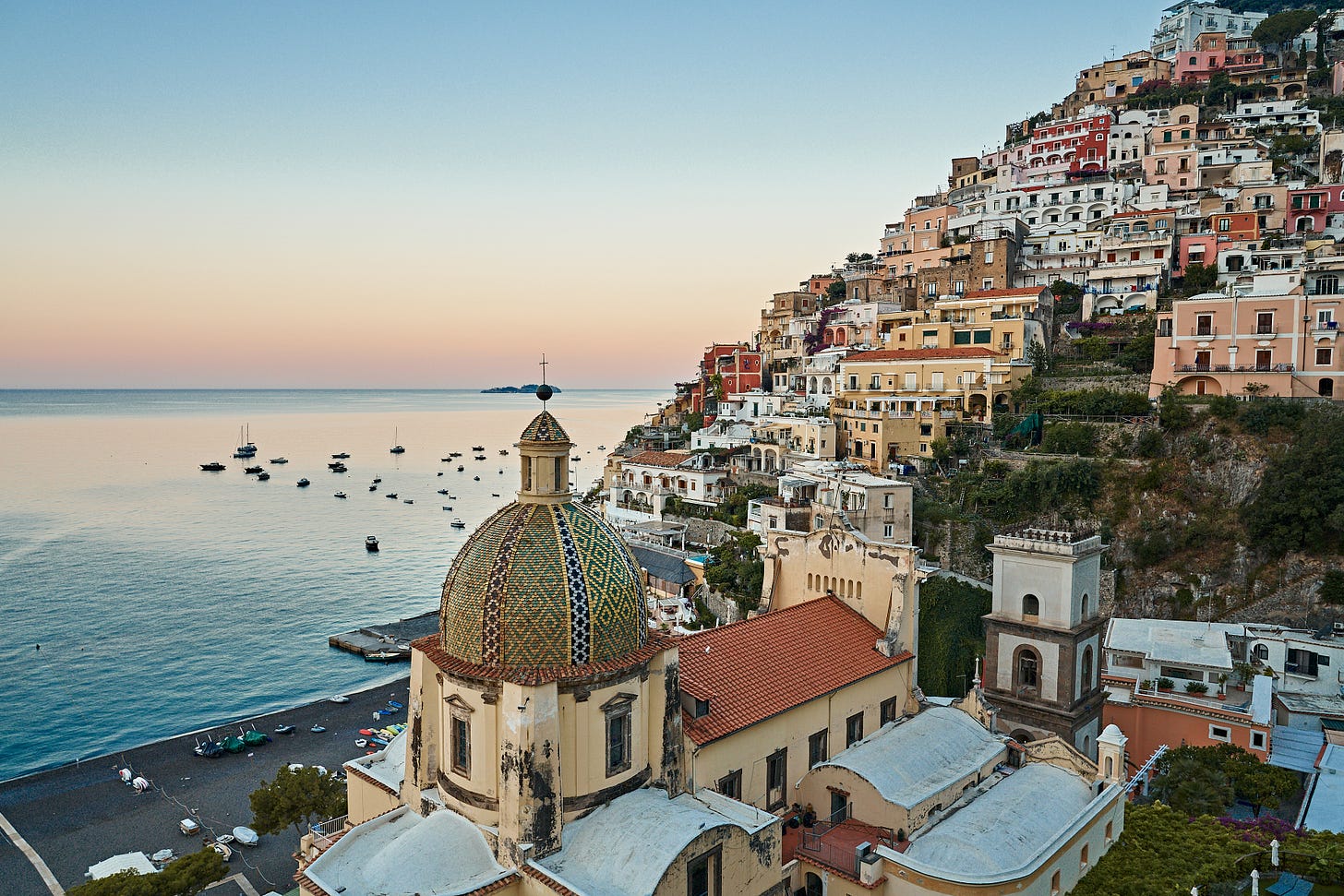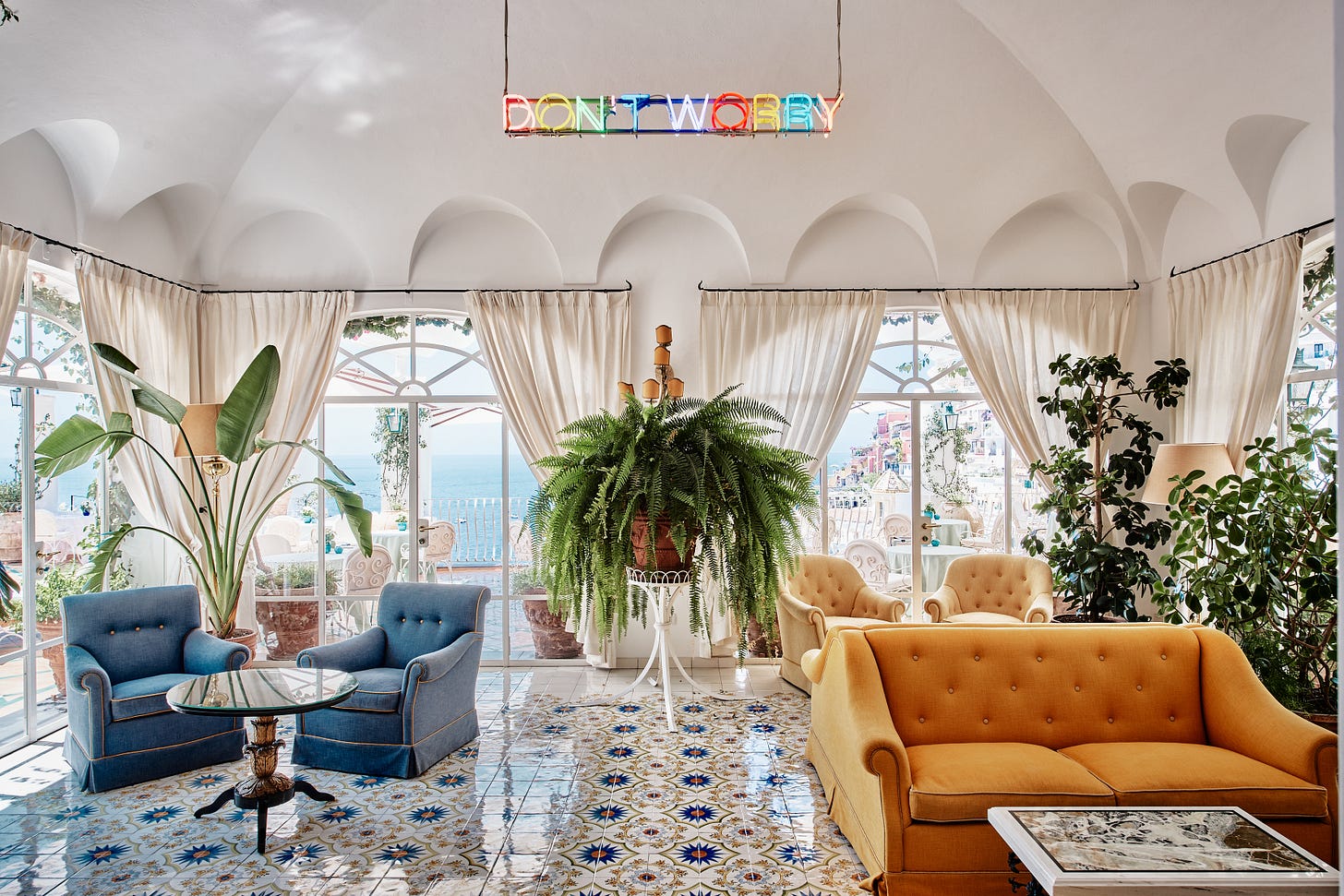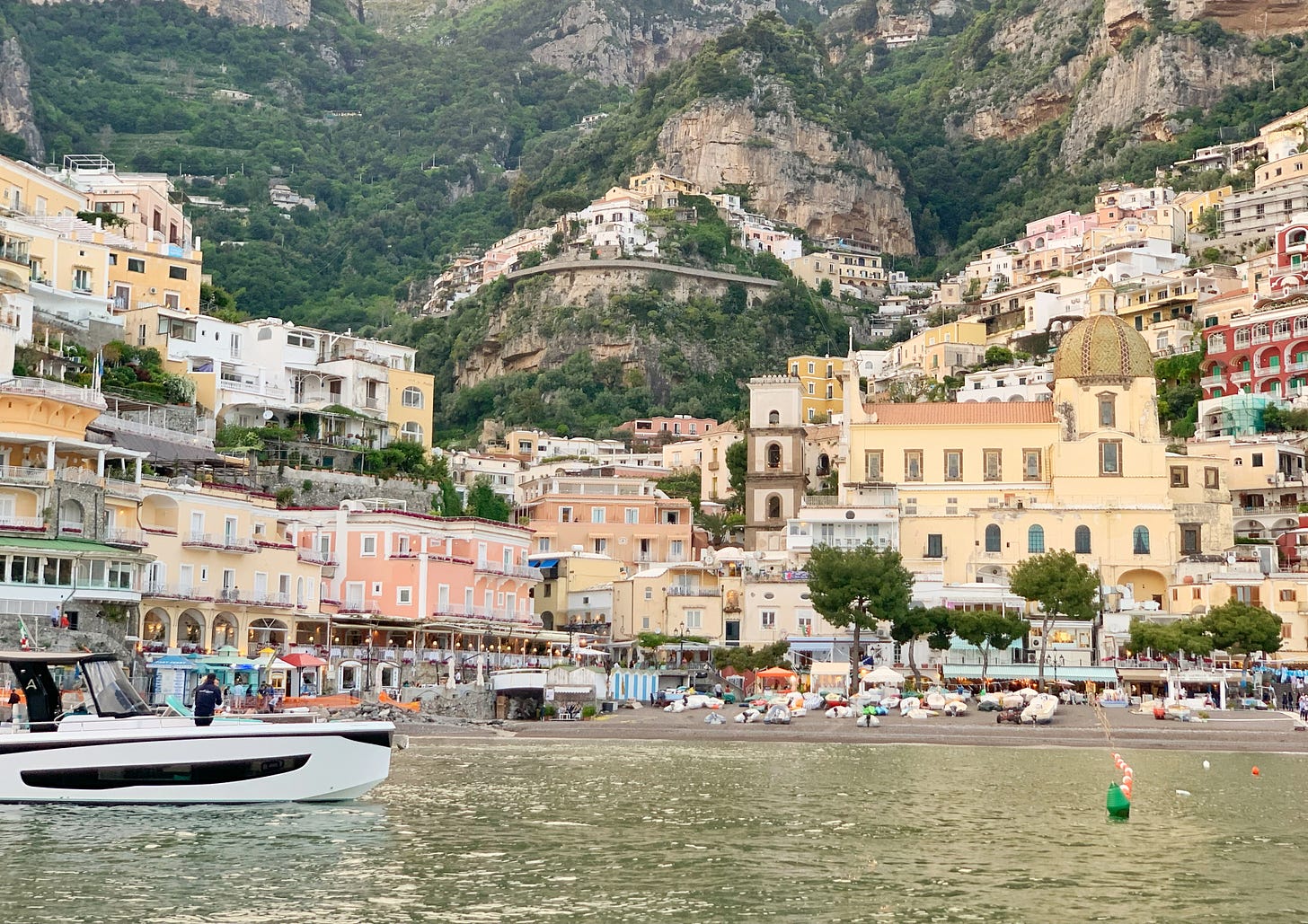There are plenty of luxurious five-star hotels around the world, but only a few that rise to the status of icon. Le Sirenuse in Positano is one of them. It opened in 1951, when siblings Anna, Aldo, Paolo, and Franco Sersale decided to transform their family’s holiday home into a little hotel with a handful of rooms. Over the course of the following decades, Le Sirenuse expanded and became not just a symbol of Italian excellence but one of the dreamiest hotels on the planet. Today, the hotel is still run by the Sersale family, with Antonio at the helm. Le Sirenuse is a member of the Leading Hotels of the World, a worldwide collection of hotels committed to upholding the very highest standards of excellence, and Antonio actively supports the association and his fellow member hoteliers.
I’ve had the good fortune of staying at Le Sirenuse and spending time with Antonio when I was invited to speak at the Leading Hotels of the World’s sales and marketing convention last September in Sardinia and at their Leading Luxury Summit in Gstaad in January, where I also met his sons Aldo and Francesco, who represent the next generation of the family’s hoteliers.
What inspires me most about Antonio and his approach is that he never rests on his laurels. He and the rest of his family are constantly looking for ways to innovate and improve the hotel, whether by collaborating with artists who create site-specific pieces, updating the hotel’s food and beverage offerings, or curating the artisan-made products at Emporio Sirenuse, the hotel’s shop. So I’m thrilled to share Antonio’s insights as part of my series of interviews with entrepreneurs and creatives in Italy.
Your family opened Le Sirenuse in 1951, right? And you took over the helm in 1992?
I came here around that time, but there was a general manager that was running the hotel, and I was under him for the first five years. He was a charming man who spent many years working for CIGA hotels.
How old were you at that point?
I was in my thirties.
When you were growing up, the hotel had already been around for a while. Did you have the sense that you would one day take over its reins?
I had a vague idea, but my timeline was completely different. I thought I would pursue my career much longer and come here at a much later age than what I actually did. I came here because my uncle asked me to. But actually, I thought I'd come here in my forties or fifties. I thought that I would pursue a hotel career and then I'd eventually come in.
And you had been abroad at that point?
Yeah, I was. So after finishing the hotel school, in 1987, I went to work in Puerto Rico at the Caribbean Hilton in San Juan. Puerto Rico was amazing. I spent one and a half years there and I loved it. And then I was doing a management training program and I had an amazing year. And then from there, I went to work in New York, first for a while at the Leading Hotels of the World and then I worked at the Mayfair Regent, which was on 65th between Madison and Park and I was an assistant food and beverage manager.
So you always had hotels in your blood. When you were growing up as a kid did you spend a lot of time at Le Sirenuse?
I always came on holiday and I was very badly behaved. I had a curfew to be in bed by a certain time and I would jump out of the window with my two cousins and we would go down to the beach and hang out and then come back into the window at night and go to the bar and mix up all the bottles of liquor and create havoc.
Amazing, I love it. Did you have a sense back then of just how iconic the hotel was? Do you think it was as iconic back then as it is now?
No, it wasn't so iconic. Because Positano was very, very, very much under the radar. You know, it was all about Capri then. Capri was a chic place. And then in the ‘70s the San Pietro opened and that stole a lot of the limelight from the hotel.
Interesting. I was wondering if Steinbeck's 1953 article about Positano for Harper's Bazaar had an effect on elevating the profile of the town and also of the hotel? Because he stayed at the hotel and wrote about it…
He wrote that long beautiful article for Harper's Bazaar. It's so lovely. And I'm sure it did, but you know, the area was underdeveloped. The hospitality wasn't so advanced. It wasn't what it is today.
So what do you think it was that transformed Le Sirenuse from a little family-run guest house into an icon?
I think one thing that helped was a movie that was filmed here called Only You with Marisa Tomei and Robert Downey Jr. in the 1990s. That was a tremendous hit. And that really helped put the hotel on the map. But it also was that people began to be more adventurous, and were willing to travel to further destinations. And, you know, we got a large international market coming here. We got Australians, Americans, people from Asia and so on and so forth.
I was actually just rereading that Steinbeck article. I love his descriptions of being driven down the Amalfi coast road by that crazy driver and walking around the town, but he says that Positano will never become full of tourists and crowded. Do you know if he returned? What do you think he would say about Positano today?
You know, the thing is, all these places have changed because the amount of people traveling today is much more than it was before. Cheap travel has encouraged more and more travelers to—rightly so—be able to travel, but it's made destinations such as this that were difficult to reach more of somewhere where people want to go.
So there are definitely more people than there were then, but when I worked in Costa Smeralda, in Sardinia, I remember that people told me that they used to go to the beach and there were cows there. So you know, many of these places have radically changed. Positano is one of them that for sure has changed with respect to 30, 40, 50 years ago. So has the amount of people traveling.
What are some strategies for people who want to visit Positano and the Amalfi Coast and have a nice experience and try to avoid the crowds?
Well, I think first of all, certain hotels like this one, for example, the San Pietro, the Santa Caterina, these are all like havens of tranquility. We don't allow anyone inside the hotel that is not a guest till 6:30 at night, when we open our bars. You have to relax by the hotel or we have a secret little stairway that takes you down to the beach, and you can get on a boat and do an excursion along the coast. That's what a lot of our hotel guests do. Or you might take your car and leave early in the morning and then go and sightsee in some other villages.
However, I think that rather than try and change places every night, you have to go to one place, stop, and then organize your life around the movement of people. So it's the same in Capri. Let's say you go to Capri, right? You can't really go to Capri for the day because then you get the worst of Capri. The best thing you can do is go to Capri and spend three, four days there and go to a beach club during the daytime and then during the night take a walk and go to the restaurants. It’s the same in Positano.
Yeah, that's exactly what I did when I was in Capri in June. I stayed for three days and spent the day out on the water or by the beach and then in town in the evening.
And it's no different here. You know, there are lovely beach clubs along the coast. There is Da Adolfo, which is fantastic. There's Lo Scoglio, which is in Nerano, La Conca del Sogno, which is down the coast. There's lots of places you can go for lunch, which are lovely.
I'm curious to hear more of your tips for the area because this summer, my husband and I spent a bit of time in Vietri Sul Mare, and I thought it was just so charming and so calm. And we were there in August. It was a very pleasant surprise to see that this beautiful little town is not crowded the way some of the other ones are. What do you think? Are there other towns worth visiting on a trip to the Amalfi Coast?
Nerano is fun because with these restaurants, you can have an amazing time. The Amalfi Coast is a haven of little undiscovered places. Cetara is very beautiful. There's some lovely restaurants and you can walk around. And there's some lovely villages above that you can go to, including Ravello and Scala, which are very nice.
There are places on the Amalfi Coast that you can go to, which are not overrun, but the thing is that you have to be strategic in your movement. You can't just rock into a car at 10 o'clock and think that you're going to get somewhere quickly because of the traffic. So you either have to leave early, or later in the afternoon.
Or take a boat?
Or of course, take a boat, which is the great thing to do here. Whenever I have friends, I always take them on a boat tour. You go for a swim and then you go to a restaurant along the coast for lunch.
You guys have a boat, right?
We have a hotel boat that used to be my late uncle's boat, which is an old wooden boat with a cabin and a bathroom. We have two seamen on it and they take you along the coast for a swim in the morning, and then they take you to Nerano and you can choose which restaurant you want to go to and have lunch at.
Which one is your pick?
I love them all. I love Maria Grazia. That's where my father had his wedding reception before I was born, of course, in the late ‘50s. My favorite amongst the three is Lo Scoglio, which is fantastic. There is La Conca del Sogno. Some people swear by Quattro Passi. There are lots of different places which are fun.
What do you think is the best time of year to visit the coast?
This year strangely enough, August was quiet. Everyone thought it would be so crazy that it turned out not to be so crazy. But I mean, I would say that May is very nice. June, September, October.
What's it like there in winter? Obviously, the hotel closes, but there must be stuff going on behind the scenes.
Very little, mostly renovation work. Everyone is like a busy bee. Everyone's working away painting, fixing, building, and it's like a hive of activity.
And are you still growing the hotel's art collection?
Very much so. We're going to do a pool with an artist. And that's very, very exciting. The inside of the pool is going to be with an artist and we've already got another artist visiting for another project that’s soon to be unveiled.
Aldo and Francesco are getting more and more involved in the hotel, aren't they?
Very much. They love the hotel. Francesco is also starting to collaborate very much with my wife at the Emporio Sirenuse and Aldo is very much involved in the hotel.
He's in the food and beverage department?
Yes, but he's sort of taking over the role of an operations manager or a resident hotel manager. He's very talented, they're both very talented. Francesco has a very good understanding of bringing the two brands closer together. And they're both very creative.
It's very interesting to see the next generation innovate. And the secret, I think, is to allow them to and not be controlling. The temptation often is: I want to do it my way. And actually, the right thing is to oversee, and try and guide them, but allow them to actually bring their input and their creativity, also, to make it stimulating for them to be in this industry.
I thought it was really great spending some time with them in Gstaad and hearing about some of their ideas and their projects. The panel discussion, for example, that Francesco was on, talking about tech and the hotel industry, and how that is moving forward, was really interesting.
It's a natural progression. A certain generation innovates to a certain point and becomes more stable, and then begins to be overtaken, and that's the point that the new generation has to come and push forward. And it's very important for that to happen. Because if that happens, the hotel can keep up with new openings.
Everyone's trying to raise the bar in this industry, as you well know. You go to these new hotels and they're just spectacular. I mean, the amount of money that these people are willing to invest is just unbelievable. It’s endless. And so you have to keep up with it. You have to make sure that your services, your facilities, every detail is on par with them.
Yes, absolutely. I think you were saying on one of the panels in Gstaad that it's also about curating the guest experience in terms of working with the artisans and the craftsmanship that's in the hotel. As you said, not every guest is going to recognize every maker, every ceramicist, or every brand of porcelain, but somebody will. You have to imagine you're not trying to dupe the guests, or cut corners, but to make something that will speak to different people in their own interests.
Yeah, my father taught me that. You have to really try and curate every aspect of the hotel because eventually there'll be someone that's an expert in the area where you try to cut a corner, and they will think, “Wow, it's quite surprising that you're trying to save money on this. You're not doing it as refined as I imagined you would.” So you really have to strive to make sure that every aspect of the hotel is as good as you can possibly imagine it to be.
I think you do a really fabulous job of that, and I definitely see my fair share of shiny new hotels that sometimes are more about looks than substance, I think. So it's very refreshing to walk into Le Sirenuse and feel that it's just so cared for. You feel the presence of your family there.
We strive, you know, it's our life. I dedicate my life to this, and I've been doing this for the past thirty years. I sometimes feel guilty that I haven't done more, that I haven't opened like five hotels, but then I think maybe it's better to do one thing well rather than three badly.
Further Reading
In the recently released list of the World’s 50 Best Hotels, Le Sirenuse was ranked number 20.
If you want to read John Steinbeck’s 1953 feature about Positano for Harper’s Bazaar, you can download the full text here.
Le Sirenuse and some of the other hotels that Antonio mentioned are featured in my article for Architectural Digest about the 7 most luxurious suites on the Amalfi Coast.
To learn more about the hotel’s contemporary art collection, check out this interview with Antonio by my colleague (and former editor) Nate Story for Surface.
For more Amalfi Coast tips, check out my guide to 72 Hours on the Amalfi Coast.
You can find all the interviews in this series here.












Wonderful story, and loved the tips about other towns to explore on the coast. Ravello is already a favorite of mine, but wasn't familiar with some of the others. Does Italy ever run out of places to see?